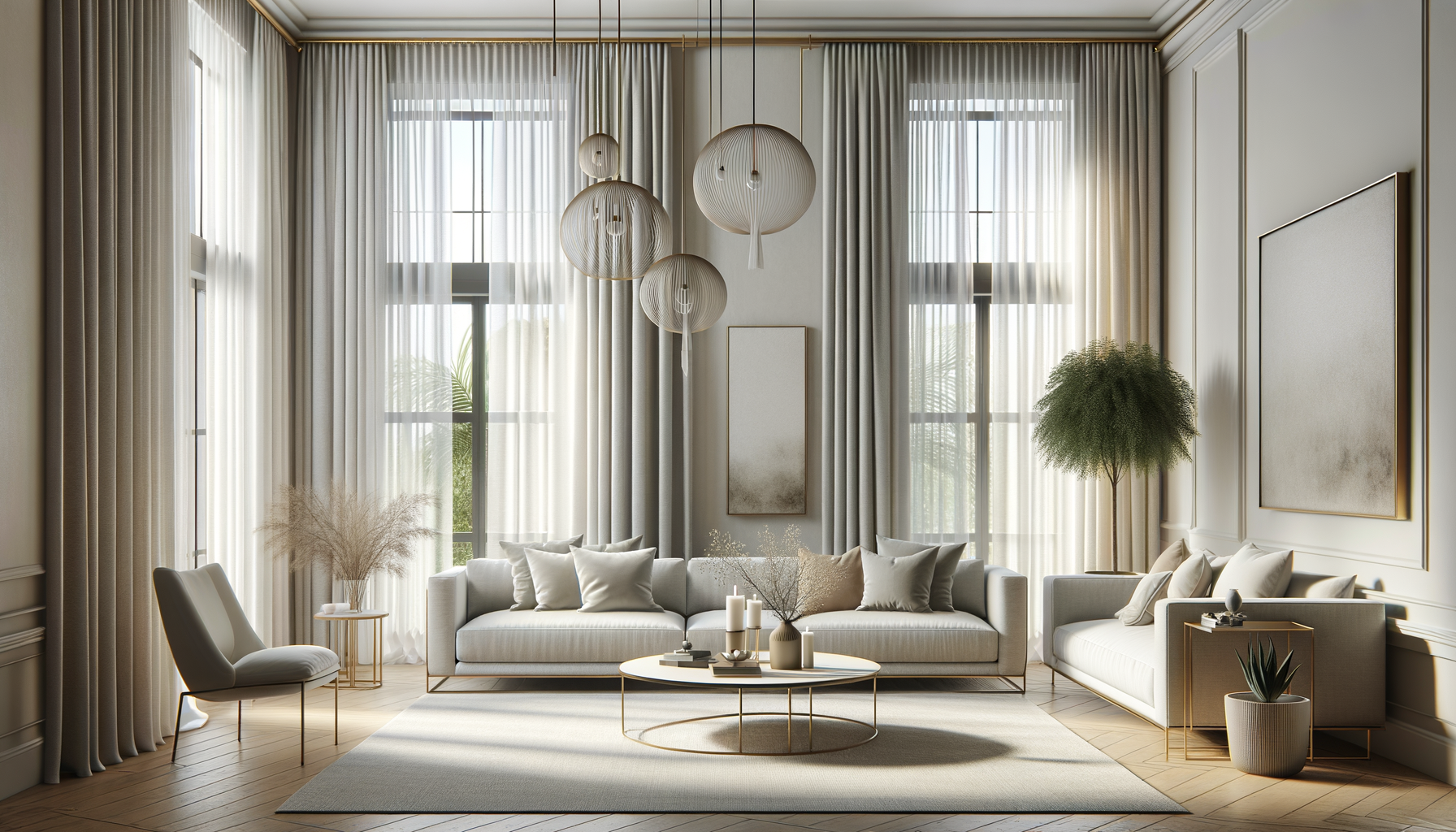Modern Window Treatments: A New Era of Style and Functionality
In today’s home design landscape, window treatments have evolved far beyond the traditional heavy drapes and elaborate valances of the past. Modern window treatments are all about marrying style with functionality, offering homeowners a way to enhance their living spaces while maintaining privacy and controlling light. The shift towards more minimalist and sleek designs reflects broader trends in home décor, where less is often more.
One of the driving forces behind this trend is the increasing popularity of open-plan living spaces. With fewer walls and more expansive windows, the need for window treatments that complement such environments has grown. Homeowners are now opting for options that allow natural light to flood in, creating bright, airy interiors that feel both welcoming and expansive. This has led to a rise in the use of sheer curtains, roller blinds, and even smart blinds that can be controlled remotely.
Modern window treatments also offer practical benefits. Many options now come with features such as UV protection, energy efficiency, and noise reduction. For example, cellular shades are designed to trap air and create a layer of insulation, helping to keep homes warmer in the winter and cooler in the summer. These functional benefits, combined with a sleek aesthetic, make modern window treatments an attractive choice for contemporary homes.
Overall, the trend towards modern window treatments is indicative of a larger shift in home design towards simplicity, functionality, and sustainability. As more homeowners seek to create environments that are both stylish and practical, the demand for innovative window solutions is likely to continue to grow.
Sheer Curtains in the Living Room: Light, Airy, and Versatile
Sheer curtains have become a popular choice for living rooms, offering a perfect blend of elegance and functionality. These lightweight, translucent fabrics allow natural light to filter into the room while maintaining a level of privacy that heavier drapes cannot provide. Sheer curtains are particularly well-suited to living rooms, where they can create a soft, inviting atmosphere that enhances the overall décor.
One of the key advantages of sheer curtains is their versatility. Available in a wide range of colors, patterns, and textures, they can be easily integrated into any design scheme. Whether your living room is decorated in a classic, contemporary, or eclectic style, there is a sheer curtain option to suit your needs. Additionally, they can be layered with other window treatments, such as blinds or heavier drapes, to provide additional privacy and light control when needed.
Sheer curtains are also an excellent choice for those looking to maximize the natural light in their living spaces. By allowing sunlight to gently diffuse into the room, they create a warm and welcoming ambiance that can make any space feel larger and more inviting. This is particularly beneficial in smaller living rooms, where the addition of sheer curtains can help to create the illusion of more space.
In conclusion, sheer curtains are a versatile and stylish option for living rooms, offering a range of benefits that make them a popular choice among homeowners. Their ability to enhance natural light, provide privacy, and complement various design styles makes them an excellent addition to any home.
Minimalist Home Décor Trends: Embracing Simplicity and Functionality
Minimalist home décor has gained significant traction in recent years, with more homeowners opting for clean lines, uncluttered spaces, and a focus on functionality. This design philosophy is rooted in the idea that less is more, encouraging individuals to declutter their environments and create spaces that are both aesthetically pleasing and highly functional.
One of the core principles of minimalist home décor is the use of a neutral color palette. Whites, grays, and earth tones are often favored, creating a calm and serene atmosphere that serves as a blank canvas for personal expression. This simplicity in color allows for flexibility in other design elements, such as furniture and accessories, which can be used to add pops of color or texture without overwhelming the space.
In terms of furniture, minimalist design emphasizes quality over quantity. Pieces are chosen for their functionality and craftsmanship, often featuring sleek, modern lines and durable materials. Multi-functional furniture, such as storage ottomans and foldable tables, is particularly popular, allowing homeowners to maximize their space without sacrificing style.
The minimalist approach also extends to home accessories and décor. Rather than filling a room with numerous decorative items, minimalist design encourages the use of a few carefully selected pieces that add character and interest. This might include a statement artwork, a sculptural vase, or a unique light fixture that serves as a focal point in the room.
Overall, minimalist home décor is about creating spaces that are both beautiful and practical, where every element serves a purpose. As more people seek to simplify their lives and create environments that promote relaxation and well-being, the popularity of minimalist design is likely to continue to grow.
Comparing Traditional and Modern Window Treatments
The evolution of window treatments from traditional to modern styles reflects broader changes in home design preferences. Traditional window treatments, such as heavy drapes and ornate valances, were often chosen for their decorative appeal. These options provided a sense of luxury and grandeur, with rich fabrics and intricate patterns that made a bold statement in any room.
However, as home design trends have shifted towards more minimalist and functional aesthetics, modern window treatments have become increasingly popular. Unlike their traditional counterparts, modern treatments prioritize simplicity and practicality. This often means opting for sleek, streamlined designs that complement a room’s architecture rather than overpowering it.
One of the main differences between traditional and modern window treatments is the focus on light control and energy efficiency. Modern options, such as cellular shades and smart blinds, offer advanced features that help regulate indoor temperatures and reduce energy costs. This is in contrast to traditional treatments, which often prioritized style over function.
Another key difference is the use of materials. While traditional window treatments often feature heavy, opulent fabrics, modern options tend to favor lightweight, durable materials that are easy to maintain. This not only enhances the practicality of modern treatments but also contributes to a cleaner, more contemporary aesthetic.
In summary, the shift from traditional to modern window treatments reflects a broader trend towards simplicity, efficiency, and sustainability in home design. As more homeowners prioritize functionality and understated elegance, modern window treatments are likely to remain a popular choice.
The Role of Technology in Modern Window Treatments
Technology has played a significant role in the evolution of modern window treatments, offering homeowners new levels of convenience and control. Smart blinds and shades, for example, can be programmed to open and close at specific times, allowing for optimal light control and energy efficiency throughout the day. This automation not only enhances the functionality of window treatments but also contributes to a more comfortable and energy-efficient home.
In addition to automation, many modern window treatments are now equipped with remote control capabilities, allowing homeowners to adjust their blinds or shades with the touch of a button. This is particularly beneficial for hard-to-reach windows or for those with mobility challenges, making it easier than ever to maintain privacy and control light levels.
Another technological advancement in window treatments is the integration of smart home systems. Many modern blinds and shades can be connected to smart home devices, such as voice-activated assistants, enabling homeowners to control their window treatments using voice commands. This seamless integration not only enhances the convenience of modern window treatments but also contributes to a more cohesive and connected home environment.
Overall, the incorporation of technology into modern window treatments has transformed the way homeowners interact with their living spaces. By offering enhanced control, convenience, and energy efficiency, these innovations are helping to redefine what is possible in home design.








